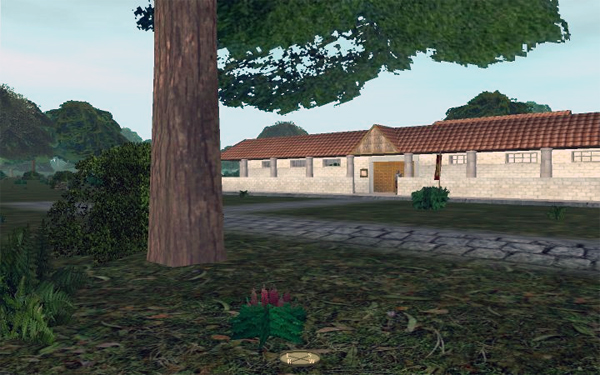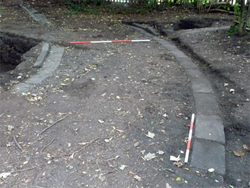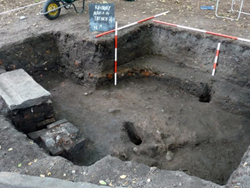
After many months and much effort, John Blackledge, a long time member of our Society, has finally completed his virtual 3D model of Wigan's Roman Bathhouse. In 2005, soon after the Bathhouse was discovered, Dave Horrocks produced his excellent 3D model, which helped to us to visualise the structure in all its glory. This new model not only provides a new insight (with a slightly different interpretation) but also enables the viewer to wander around the site in real time. You can also interact with it, opening doors, etc.. even talk to some of the characters who wander around the site. To download the model, all you need to do is visit this website http://www.tla-data.co.uk/3dw/3dworlds.htm
John has set up a special link that will enable you to install the programme and download the model in one go (a word of caution for Vista or Windows 7 uses, make sure you install the programme to your user folder as instructed).
John has included fort walls around the site, which is perhaps taking liberties at this stage but who cares - the programme is great fun and gives you a real sense of how it might have been (John will be able to update his model quite easily as our knowledge of Roman Wigan increases).
Rectory Update
 We have been making steady progress here over the summer months, in particular Area 4, where we are looking for the continuation of the old Frog Lane (Area 4 is in the east corner of the grounds on the right hand side of the hall entrance). Earlier in the year, we came across well preserved curbing enclosing a metalled track which curves across the whole of our site. We soon realised, however, that this was not the old lane as it wasn't wide enough and it was heading in the wrong direction. The likelihood is that this is the garden track put in when the hall was constructed in 1875 (a track is shown in this area on the 1893 OS map). The track disappears into the north side fence (where the site has been trunked by the tech buildings) but re-emerges further north as it leads towards the front of the hall. We have been making steady progress here over the summer months, in particular Area 4, where we are looking for the continuation of the old Frog Lane (Area 4 is in the east corner of the grounds on the right hand side of the hall entrance). Earlier in the year, we came across well preserved curbing enclosing a metalled track which curves across the whole of our site. We soon realised, however, that this was not the old lane as it wasn't wide enough and it was heading in the wrong direction. The likelihood is that this is the garden track put in when the hall was constructed in 1875 (a track is shown in this area on the 1893 OS map). The track disappears into the north side fence (where the site has been trunked by the tech buildings) but re-emerges further north as it leads towards the front of the hall.
 Our further investigations have revealed that the track is laid on top of a soil and rubble fill, which has been used to build up the ground level in this area. Our trench adjacent to the track is now getting quite deep as we attempt to reach the archaeology. Although some features have turned up, frustratingly the old lane still remains elusive. Features discovered include a stone capped brick plinth (we have no idea of its function) and a finely gravelled surface at a depth of about 60cm. This surface, although quite low down, is not particularly old as it lies on top of more brick rubble and soil fill (holes and cavities have also appeared which we believe may have been created by animal activity). Our further investigations have revealed that the track is laid on top of a soil and rubble fill, which has been used to build up the ground level in this area. Our trench adjacent to the track is now getting quite deep as we attempt to reach the archaeology. Although some features have turned up, frustratingly the old lane still remains elusive. Features discovered include a stone capped brick plinth (we have no idea of its function) and a finely gravelled surface at a depth of about 60cm. This surface, although quite low down, is not particularly old as it lies on top of more brick rubble and soil fill (holes and cavities have also appeared which we believe may have been created by animal activity).
Our intention is to carry on in this area. However we are limited on the depth we are allowed to dig (2m) so we are also looking to move to our next area which is the lawn behind the hall. Resistivity here has indicated some possible features (as usual, latest details on our Forum).
Next Meeting
Wednesday 5th October - at the Pagefield Hotel, which is our new venue, starting at 730pm as usual. This month we have Dr Steven Snape who is the Senior Lecturer in Egyptian Archaeology at Liverpool University. He is also Director of Archaeological Collections and Keeper of the University's Garstang Museum (John Garstang was an archaeologist working in Egypt at the beginning of the 20th century. Some of his finds are currently on display in an exhibition in the Kendal Museum in Cumbria).
Dr Snape will be giving us a talk on his own work in the western Egyptian desert where he has been excavating over many years. The title of his talk is "Ramesses II and the Fortress at the End of the World" - hope to see you there, - BA
|



